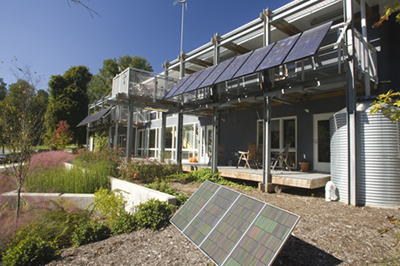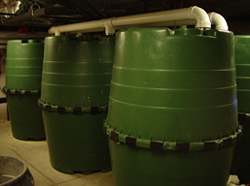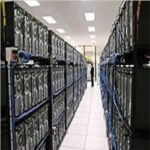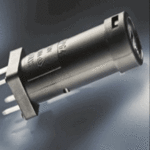Not Your Father’s Dorm: Smart Students and Their Smart House
Not Your Father’s Dorm: Smart Students and Their Smart House
Juniper Research has valued the smart home market at $60B by 2017
When I started researching this article, I contacted a number of connector companies (10 to be exact) and asked to interview their experts on intelligent home applications.
That was a mistake.
Each and every company told me they didn’t really focus on that market. One did have an intelligent buildings team, but that was for commercial projects, not residential. They all tried to help, but were hard-pressed to name a smart home “expert.”
So I Googled. And after just a half-hour reading about smart home expos, end-products, applications, and tutorial websites, I realized I wasn’t asking the right question.
It’s not about connector manufacturers supplying components specifically for intelligent homes; it’s about the advanced solutions they’ve already developed for existing applications and how they may be adapted for intelligent home design. The applications already exist — audio/video, security, solar power, HVAC; they’re just being tweaked for residential (and commercial) use to make buildings more efficient. The intelligent home segment is less of a marketplace and more of a target segment within a number of markets.
A Growing Market
 Juniper Research has valued the smart home market at $60B by 2017, rising from $25 billion in 2012 and driven by strong growth within the smart home entertainment segment, along with contributions from other segments, including smart monitoring and control and “Smart Health.” As broadband connectivity evolves from traditional uses to more novel applications, such as connected TV, smart meters, and home automation systems, the potential for increased service revenue in these segments will further drive developments in the technology and adoption of the services. For example, according to Jupiter, the smart home entertainment segment will account for 82% of total service revenue by 2017, driven by North America and Western Europe.
Juniper Research has valued the smart home market at $60B by 2017, rising from $25 billion in 2012 and driven by strong growth within the smart home entertainment segment, along with contributions from other segments, including smart monitoring and control and “Smart Health.” As broadband connectivity evolves from traditional uses to more novel applications, such as connected TV, smart meters, and home automation systems, the potential for increased service revenue in these segments will further drive developments in the technology and adoption of the services. For example, according to Jupiter, the smart home entertainment segment will account for 82% of total service revenue by 2017, driven by North America and Western Europe.
A smart home connects and integrates all the smart technology throughout the home, putting all devices that consume energy on a grid so they can be monitored individually and evaluated against the home’s overall consumption. A smart home is built to conserve energy while allowing the household to examine its energy use and find ways to further cut back and conserve.
Collaboration Required
Unlike most markets, the success of the smart home market will depend on the cooperation among many entities, not just on the leadership of a few OEMs that will forge ahead in systems design. A smart home depends on the reliability and innovation of mobile networks, service providers, smartphone and laptop manufacturers, and system design engineers, as well as architects, builders, and landscapers. The smart home market requires collaboration and cross-industry cooperation before it can be an option for the mass market, moving from its current position as a high-end choice to being a standard expectation in home design.
According to the GSMA, an organization representing mobile operators, the smart home of the future is likely to contain 15 to 30 connected devices and sensors, all linked via a home area network and connected to service providers’ back-end systems and the Internet. Connected devices will range from ordinary household appliances to solar panels and electric vehicle charging infrastructures that both consume and generate electricity. Functions being automated and incorporated into smart homes include centralized lighting control, HVAC (heating, ventilation, and air conditioning), appliances, security locks, control of domestic activities such as home entertainment systems, houseplant and yard watering, pet feeding, changing the ambiance “scenes” for different events (such as dinners or parties), domestic robots, and medical monitoring for the sick and elderly.
The collaboration that will be necessary to make smart homes the de facto standard for all homeowners is already at work in one corner of North Carolina. On the leafy campus of Duke University, 10 students are living in a laboratory — the Home Depot Duke Smart Home. The residence opened its doors in 2007, and is the brainchild of a former student at Duke’s Pratt School of Engineering.
The Smart Dorm
 “Our main goal with this program is to enable sustainable living — and we do that through teaching and hands-on research,” said Jim Gaston, Duke Smart Home program director. “We recognize that our society must embrace clean, green living strategies in order to ensure quality of life for the future. And this means working in diverse teams and taking new approaches to solving longstanding problems.”
“Our main goal with this program is to enable sustainable living — and we do that through teaching and hands-on research,” said Jim Gaston, Duke Smart Home program director. “We recognize that our society must embrace clean, green living strategies in order to ensure quality of life for the future. And this means working in diverse teams and taking new approaches to solving longstanding problems.”
The Home Depot Smart Home is a 6,000-square-foot, live-in research laboratory that contributes to the innovation and demonstration of future residential building technology. The central concept of this project is the belief that smart homes can improve that quality of life for people of all ages and incomes. The Home Depot Smart Home provides students at Duke’s Pratt School of Engineering, Trinity School of Arts and Sciences, and Nicholas School for the Environment and Earth Sciences with an opportunity for practical hands-on engineering, outside of the classroom, in a living and learning community. In addition, the school is partnering with industry to strengthen the residential market for integrated technology and help homeowners make their own ideas for smart homes a reality.

“The Smart Home at Duke University is not a demonstration building of what a house should be in the future; it’s a laboratory where the students live with access to all the different technologies, so they can come up with ideas and try to build a prototype to make life better,” said Jim Gaston, Duke Smart Home program director.
The students who live in the house are expected to contribute to the Smart Home Program as a member of the Executive Board, a project team, or the tour guide program. Students across campus can also take classes that focus on developing technology for use in the house as well as join in non-credit projects.
Students were involved with every step on the road to making the house a reality: securing campus approvals, building support in the community, fundraising, partnering with industry leaders, design, and construction.

The Smart Home incorporates design features such as a high-ceilinged common area to encourage passive airflow and a “chimney effect”; showers that use hot water generated from the solar hot water system on the roof; and toilets that use water collected from the rainwater harvesting system, with ENERGY STAR-certified appliances from LG and GE. From there, improvements and entirely new features will be designed and built by the students on-site. The house has a clean lab with computers, an e-Print printer station, and monitors for various systems in the house, including the main light control panel and monitor panels from the solar hot water and solar power systems; a dirty lab for performing experiments and building things, equipped with almost everything that will help a student with an idea to work through a problem; a two-person lab counter in each bedroom as extra working space for projects; Smart Panels set up at specific locations to test projects and incorporate devices within the entire home; and a special laboratory site in the basement for experimenting with products from corporate partners that are not yet on the market.
Additionally, the Home Depot Smart Home has earned a platinum rating in LEED (Leadership in Energy and Environmental Design) from the United States Green Building Council, widely considered to be the highest possible achievement in green building. LEED is an opportunity for all team members on a building project to unite around the common goal of building in a more sustainable way. A number of the home’s key design features played a role in earning the certification:
Green roof. A green roof is an area of roof surface that is covered with living plant matter. In the case of the Smart Home, the green roof is populated with sedums, which are low-maintenance and drought-resistant. The green roof prevents heat gain; encourages evaporation, which results in a cooling effect on the building; and pre-filters rainwater for re-use later.
 Rainwater for irrigation. The irrigation system for the Smart Home uses 100% captured rainwater. This guarantees that no public water will ever be used to water vegetation on the Smart Home site. The rainwater is collected from roof run-off and stored in two 1,000-gallon storage tanks for later use.
Rainwater for irrigation. The irrigation system for the Smart Home uses 100% captured rainwater. This guarantees that no public water will ever be used to water vegetation on the Smart Home site. The rainwater is collected from roof run-off and stored in two 1,000-gallon storage tanks for later use.
Photovoltaic panels. At the Smart Home, there is an array of 18 160-watt photovoltaic panels, which create a ~3kW solar power station. The energy generated by the panels is connected to the public power grid and puts energy back onto the grid for use by the neighbors. It also reduces the total energy consumed by the Smart Home by about 30%.
Construction waste management. All waste generated at the Smart Home site during construction is placed in a single bin for convenience. When the bin is collected, it is taken to a sorting facility where the waste is separated into disposables and recyclables. Using this process, more than half of the total waste is being diverted from landfills.
The Team Approach
Now that the house is open for student living, the home’s systems will be continuously enhanced and updated through student projects. To this end, the goal each semester is for just half the residents to be engineering students, while the other five are enrolled in programs outside the engineering school.
“We really emphasize a disciplinary approach to these types of problems,” said Gaston. “And we realize that it’s not just the technical solution that the engineers tend to focus on, but it’s oftentimes environmental or public policy or social or economic, so we really encourage students to have diverse teams when they’re working on the projects.”
The Smart Home is an example of Duke’s attitude toward student creativity and engagement as part of their education. One goal of the program is to install at least one student-developed technology in the dorm each year, while providing the resources, guidance, and infrastructure to move as many projects — whether for-credit or non-credit, student- or faculty-generated — through the design process and to an install-ready stage. In part, that is supported by the Smart Home Club, which is open to students across the Duke campus, whether or not they live in the dorm. The aim of the club is to engage students in conceiving, building, and deploying technology-based solutions. Student projects are limited only by student creativity, and are not limited in scope by the program’s focus on energy efficiency, sustainability, or smart living. Current projects include the design of a more useful shower caddy, mobile lighting controls, wireless power transmission, and outputting traditional sensor data as sound.
“People talk about the Internet of Things, where everything is connected — the thermostat, the security system, the media room, the lights — to your cell phone and your computer so you can monitor and control it,” said Gaston. “I think the real challenge is getting all these devices connected together, where you can monitor the information and make some decisions — adjust the temperature in your house, turn the lights off, make sure the security system is set — and it all needs to be done by your smartphone. All these devices speak different languages and understanding how to get those connected, both software and hardware, is the next challenge for engineers.
“Industry has shown an enduring interest in this program, from partnering with us to design and construct the dorm to engaging students in industry-relevant projects to welcoming students into internship experiences. We continue to welcome such involvement — it’s the reason why we’re here: to help prepare students to succeed in the real world.




